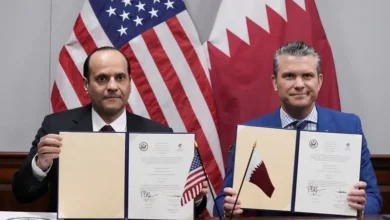Who are the Houthis? A simple guide to the Yemeni group

Following weeks of Houthi-led attacks on vessels in the Red Sea, the United States and United Kingdom have launched military strikes in Yemen in response, which the Houthis have described as “barbaric”.
The Houthis are an Iran-aligned group based in Yemen and have said their attacks are a response to Israel’s bombardment of Gaza, and the international community’s failure to put an end to it.
The Houthis have primarily targeted Israel-linked ships and in December, the US formed a multilateral coalition to safeguard commercial traffic from attacks. The force now has more than 20 countries, according to the Pentagon.
But who are the Yemeni fighters at the heart of this escalation?
Who are the Houthis?
The Houthis, also known as Ansar Allah (supporters of God), are an armed group that control most parts of Yemen, including the capital, Sanaa, and some of the western and northern areas close to Saudi Arabia.
The Houthis emerged in the 1990s but rose to prominence in 2014, when the group rebelled against Yemen’s government, causing it to step down and sparking a crippling humanitarian crisis.
The group then spent years, with Iran’s backing, fighting a military coalition led by Saudi Arabia. The two warring sides have also repeatedly tried to hold peace talks.
However, analysts say the Shia group should not be seen as an Iranian proxy. It has its own base, its own interests – and its own ambitions.
What’s the status of Yemen’s civil war?
Yemen has been in a decade-long civil war as the Houthis maintain control of parts of the country. The group has been in ceasefire talks with Saudi Arabia while Yemen’s official government is based in Aden and led by President Rashad al-Alimi.
Al-Alimi came into office in 2022 after the country’s exiled president Abd-Rabbu Mansour Hadi ceded power to him. Relations between Hadi and the Houthis were especially fraught.
Yemen’s civil war has plunged the country into what the United Nations called “the world’s worst humanitarian crisis”, in March 2023.
An estimated 21.6 million people or two-thirds of Yemen’s population are “in dire need of humanitarian assistance and protection services”, according to the UN.
Fighting between Houthis and the military coalition, however, largely subsided last year. In 2023, the Yemeni rebels and government forces also exchanged about 800 prisoners over three days.
The Houthis have been engaging in Omani-mediated talks with Saudi officials to negotiate a permanent ceasefire. Saudi Arabia also restored relations with Iran in 2023, raising hopes for the Yemen peace process.
Why are the Houthis attacking Red Sea ships?
The Houthis say their attacks on commercial and military ships with potential Israeli links are primarily aimed at pressuring Tel Aviv to end its war on Gaza. On November 18, the group took over a cargo ship called the Galaxy Leader, which they have since turned into a tourist attraction for Yemenis.
The Houthis have also said they will continue to attack Israel-linked ships even after the strikes on Yemen by the US and UK on Thursday.
“They were wrong if they thought that they would deter Yemen from supporting Palestine and Gaza,” Abdulsalam wrote online. The group’s “targeting will continue to affect Israeli ships or those heading to the ports of occupied Palestine,” he wrote.
The group has also been demanding that Israel allow increased humanitarian aid into Gaza.
But analysts also say that attacks help the Houthis in other ways. Domestically in Yemen, the group has seen a sharp uptick in recruitment, riding on popular support for the people of Gaza. The attacks, and the response from major powers like the US, also force other countries and governments to negotiate with them, giving them de facto legitimacy at a time when they are not officially recognised internationally as Yemen’s government.
The Red Sea and Suez Canal account for 30 percent of the world’s container ship traffic and since the onset of attacks, several shipping companies have said they will divert ships across Africa instead.










